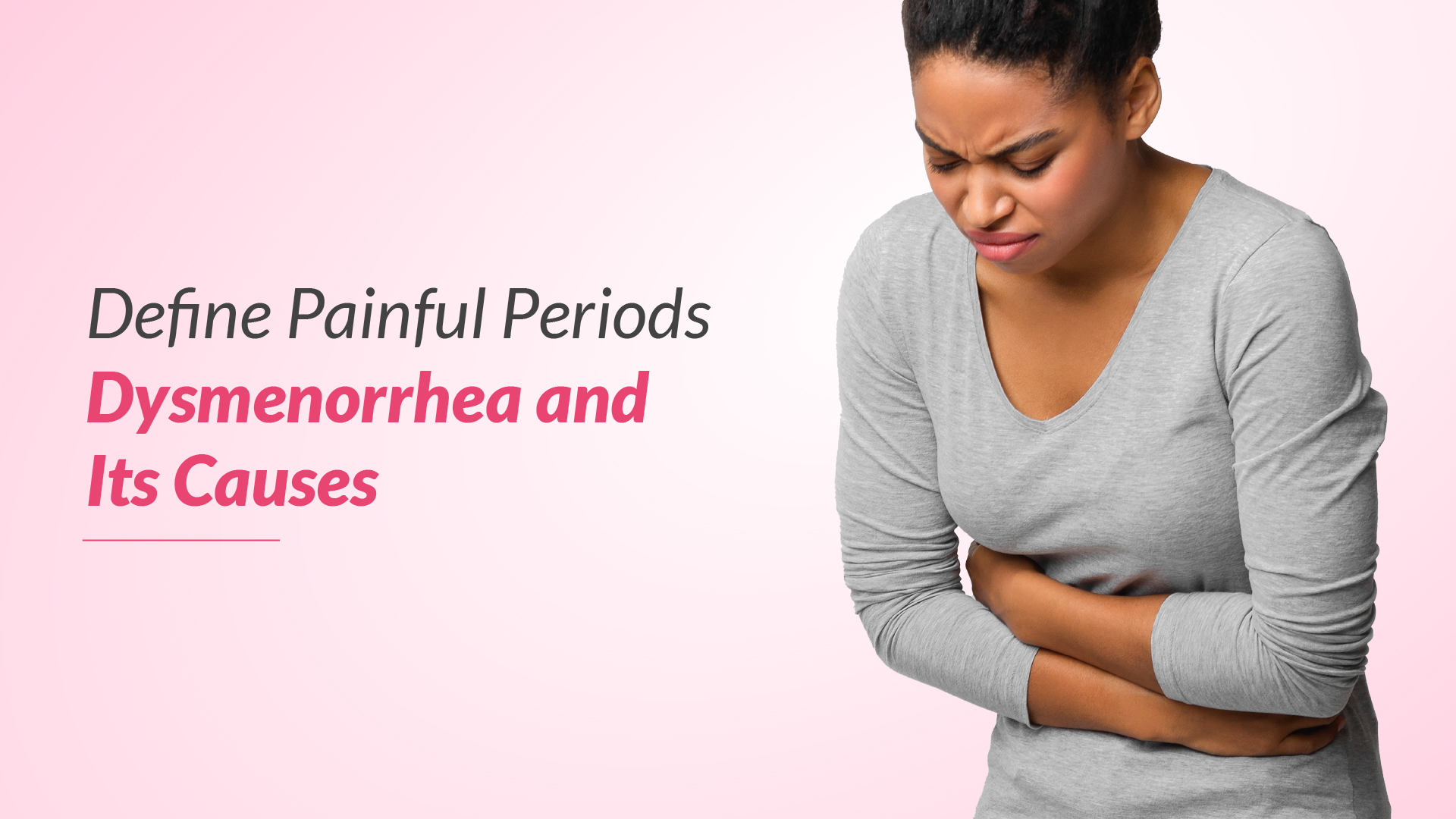Define Painful Periods / Dysmenorrhea and Its Causes
Reviewed By: Dr. Shruthi Mantri, fertility specialist at Ferty9 Fertility Center, L. B. Nagar
Pain experienced throughout the menstrual period is known as dysmenorrhea. Usually originating in the lower abdomen, the pain can also spread to the back and inner thighs. It may severely affect a patient's life and is a relatively prevalent gynecologic issue. Several therapy options are available to patients who may seek medical help and treatment.
What is Dysmenorrhea?
Periods, also known as menstruation, are regular episodes of vaginal bleeding that occur during a woman's monthly cycle. Dysmenorrhea is defined as the condition in which women experience painful menstruation cycles and typically have episodic, sharp, or throbbing lower abdominal cramps. Other symptoms include headaches, nausea, diarrhea, leg pain, and lower back discomfort.
Also read: How to stop period’s pain?
Types of Dysmenorrhea
Depending on the cause, painful menstrual cycles can be classified into two groups:
- Primary Dysmenorrhea
- Secondary Dysmenorrhea
Menstrual discomfort that arises around the onset of the menstrual cycle in otherwise healthy young women is known as primary dysmenorrhea. Most of the time, there is no specific issue with the uterus or other pelvic organs causing this pain. It is believed that this illness is caused by an increase in the activity of the uterine hormone prostaglandin.
Menstrual discomfort that appears later in women who have had regular periods is known as secondary dysmenorrhea. It is frequently linked to issues with the uterus or other pelvic organs, including endometriosis, fibroids, stress, and other conditions.
Related read: Birth Control Pills and Their Effect on Menstrual Cycles and Women's Health
Symptoms of Dysmenorrhea
The symptoms include
- Throbbing or cramping in the upper thighs, lower back, or lower abdomen
- Pain that radiates down the legs
- Abdominal pressure
- Vomiting, diarrhea, bloating, or nausea
- Headaches and mood swings
- Weakness, exhaustion, or fainting
- Constipation
Also read: Irregular Periods: A warning sign to be taken care of
Causes of Primary Dysmenorrhea
It is the most common type of dysmenorrhea. It is more frequent in women in their early 20s, and in most cases, it diminishes by the age of thirty. Due to a chemical imbalance in the body, women who have primary dysmenorrhea experience abnormal uterine contractions. Pain generally begins one or two days before your period or when bleeding starts.
- Increased Prostaglandin Production: The major cause of primary dysmenorrhea is thought to be elevated levels of prostaglandins (PGs), which are substances that trigger uterine contractions. During menstruation, endometrial cells break and emit PGF2α, a prostaglandin.
- Genetic Predisposition: A positive family history of dysmenorrhea is a significant risk factor. A genetic component plays a part in the development of primary dysmenorrhea, which enhances a familial tendency.
- Uterine Contractions: Tissue hypoxia and ischemia brought on by uterine contractions result in pain, occasionally accompanied by nausea and diarrhea.
- Nerve Sensitivity: Nerve sensitivity plays a significant role in primary dysmenorrhea. Elevated prostaglandin levels cause uterine contractions, which increase nerve sensitivity and amplify pain. This heightened sensitivity contributes to the severe period cramps experienced by individuals with primary dysmenorrhea.
- Immature Uterine Development: Immature uterine development can contribute to primary dysmenorrhea. In adolescents, the uterus may not be fully developed, leading to inefficient uterine contractions and increased pain during menstruation. This condition often improves as the reproductive system matures.
Also read: Four Phases of Menstrual Cycle
Causes of Secondary Dysmenorrhea
Secondary dysmenorrhea occurs less often in older age groups. It is brought on by conditions like endometriosis and uterine fibroids that impact your uterus or other reproductive organs. With time, this type of pain frequently grows worse. It might start before your menstruation starts and continue after.
- Endometriosis: It is a condition that occurs when the endometrium, the tissue that lines your uterus, develops outside of it. Pain, swelling, and scarring may result from these tissue fragments because they bleed during your menstrual cycle.
- Uterine Fibroids: Noncancerous growths within, outside, or within the uterine wall can cause secondary dysmenorrhea.
- Adenomyosis: An abnormality where the lining of your uterus grows into its muscle. Your uterus may enlarge significantly as a result of this illness, and you may also have pain and irregular bleeding.
- Pelvic Inflammatory Disease (PID): PID is a bacterial infection that originates in the uterus and may spread to the other reproductive organs. Pain during sex or in your stomach might be symptoms of PID.
- Cervical Stenosis: A situation in which your cervix narrows due to a procedure, medication, or another illness.
Also Read: Gynecological Disorders that Women Must Never Ignore
Who is More Likely to Have Dysmenorrhea?
Period pain might be more likely to occur if:
- You had your first menstrual cycle before turning twelve
- You are under 20 years old
- You have heavy or longer-than-seven-day periods
- You have a family history of dysmenorrhea
Find Hope and Solutions for Female Infertility and Male Infertility
Diagnosis and Tests
It is essential to seek medical attention for both primary and secondary menstrual cramps, as they are curable. By putting a speculum into your vagina, a pelvic exam can be done to find out whether there is a medical problem causing dysmenorrhea. Your doctor will diagnose you with primary dysmenorrhea if there isn't a clear medical cause.
To rule out secondary dysmenorrhea and to gain a better look at your uterus and other reproductive organs, your physician can do imaging and other diagnostic testing. Ultrasound, hysteroscopy, and laparoscopy are done, and if testing reveals that you have a medical problem that is causing your menstruation to be painful, your doctor will speak to you about treatment options.
Difference Between Normal Cramps and Dysmenorrhea
The severity, onset, and duration of pain are the primary differences between dysmenorrhea and regular period cramps.
| Normal cramps | Dysmenorrhea |
|---|---|
| Mild to severe pain | Sharp or sudden intense pain |
| Start a day or two before your periods | One to three days before your period |
| Pain lasts two to three days | Pain lasts up to 72 hours |
| Nausea, vomiting, diarrhea, headaches, and other symptoms | Nausea, vomiting, fatigue, weakness, fainting, or headaches |
| Pain in the lower abdomen | Pain radiates to the lower back and inner thighs |
Related Read: Signs and Symptoms of Female Infertility
How Can You Relieve Menstrual Cramps?
There are many ways to relieve menstrual cramps, such as pain relievers, heat pads, massage, exercise, diet, rest, relaxation, supplements, and complementary therapies such as yoga and breathing exercises.
Find Hope and Solutions for Infertility Problems—Explore Our Comprehensive Services
IVF Treatment
IUI Treatment
ICSI Treatment
Fertility Preservation Service
Blastocyst Culture & Transfer Treatment
Conclusion
Dysmenorrhea is a prevalent menstruation complaint that significantly affects a considerable number of women of reproductive age; however, significant discomfort that impairs everyday activities is less frequent. All types of dysmenorrhea can be treated effectively with advanced medical and scientific methods.
Visit Our Clinic:
Fertility Clinic in Hyderabad
Fertility Clinic in Visakhapatnam
Fertility Clinic in Vijayawada
Fertility Clinic in Karimnagar
Fertility Clinic in Warangal
Fertility Clinic in Rajahmundry
Fertility Clinic in Tirupati
Fertility Clinic in Kurnool

Write your message


